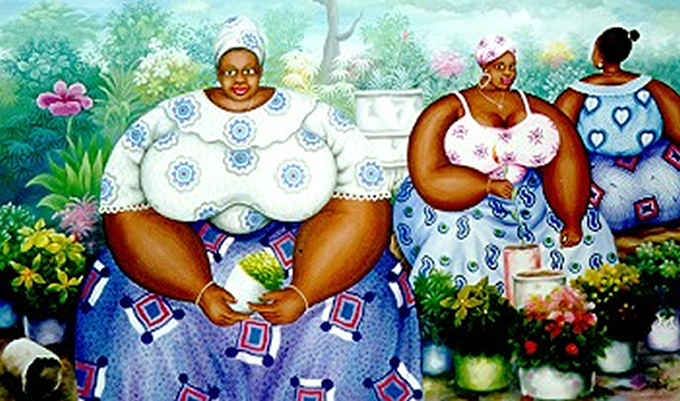Aka Augustin Kassi was born in 1966 in Assoumoukro, an Akan Village of Cote d’Ivoire. He spent the first years of his life in the village then went to secondary school in a small town which he left to study at the Artistic Centre of Abengourou for three years. Drawing and painting have been his passion since his childhood. When I went to interview him for Safarimate, his welcome was straightforward and friendly. With a smile as warm as the light that emanates from his paintings, he said to me: “If you go to my village you will see what I drew with charcoal bits on the walls of my father’s house when I was a little boy, before my school years. It is still there.” I did not go to Kassi’s village but I had the chance to meet him in his studio.
I could see unfinished paintings, his easels, brushes and pots of paint. They looked so ordinary, contrasting with the striking power of the paintings, by him or other artists, hanging all over the walls. Assamala Amoi: Mr. Kassi, for you, is a beautiful woman a fat woman?
Kassi: In general, I find that women are beautiful but the criteria change. In the past in Africa, fat women were considered the most beautiful; and fat men were seen as respectable, successful and powerful. Then, fatness was a sign of prosperity. Nowadays, only slim women are perceived as beautiful. The fat ones are laughed at and despised. Fatness is considered a disease. God has created fat women, painting them is my way of celebrating and appreciating them. I was very pleased one day when I discovered a seamstress who sews for fat women and organises fashion shows with fat models.
Assamala Amoi: Do you paint fat women to compensate the lack of everything, the present economic crisis?
Kassi: Yes. I also support fat women to compensate my small size. I am interested in the cultural and aesthetic aspects of fatness. I also paint fat women for therapeutic reasons because I want them to get rid of their complexes, to prevent them from marginalising themselves and shutting themselves up. In addition to this, I like wide spaces. I can’t stand emptiness.
Assamala Amoi: The apparent bloom and size of your characters makes one feel like touching them. Is it your aim?
Kassi: (Laughter.) I have not thought of this as my aim. If some people feel attracted,
Kassi’s painting illustrating a calender.
Kassi standing next to one of his paintings.
others feel repulsion and find my characters monstrous. One of my goals is to break away from what is established by the West. Even Picasso got his inspiration from Africa so why should I cut off my roots? Assamala Amoi: Do you think that African art has the place it deserves in the world of art?
Kassi: Not completely. I am still working at it. For instance, let us think of the Vohou Vohou movement led by Youssouf Bath and N’Guessan Kra. It has nothing to do with the teaching of Western art and it is successful. I want the Naive Art to be respected. I would like to point out that Idrissa Diarra and Camille Kouakou are the two other artists who contributed to the promotion of the Naive Art in Cote d’Ivoire. However, we must resist the temptation to draw on order for tourists. As for me, I want to be free to follow my inspiration and my imagination. Before painting fat women I used to draw landscapes. Today, my work is much copied so I want to cultivate originality. Evolution is important to me, I do not want to remain at the same stage. My work has gained a certain recognition, I am invited to exhibitions and it sells well.
Assamala Amoi: What can you say about your artistic style, the Naive Art?
Kassi: (His speech becomes more and more passionate.) Well, because of it I was rejected from the school of Fine Arts of Abidjan. I was told that my place was not there. I have to confess my suspicion towards abstract artists because most of them think highly of themselves although they do not know how to draw. I urge people to stop considering Naive Art as a low category of expression. I consider it to be my life-long mission to convince everyone that “naive” does not mean artless, childish and meaningless. On the contrary, thanks to its vivid colours and precision on details, this form of art is highly symbolic, it expresses life and attracts people. My ambition is to prove that my work deserves to be bought at the same prices as are the so-called “superior” works of art, and to be exhibited in art galleries. I am convinced that meetings between artists are always an opportunity to broaden one’s view and nourish inspiration. Artists must exchange, no matter how different their styles are.
Kassi kindly agreed to let me add these lines as his work inspired me:
The eyes of his women are African lakes and dawns at hand;
Their smiles are fresh sources surrounded by hibiscus flowers;
Their bodies are fruit generous fed by light and heat;
Their skins are the colours of sunsets and dark earth;
Their strength and their softness
conquer souls, space, life….




















